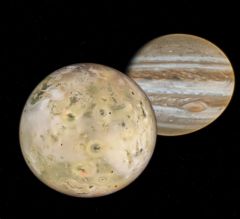Difference between revisions of "Io"
Jump to navigation
Jump to search
(Added Template:SolarSystem.) |
(Added template and content.) |
||
| Line 1: | Line 1: | ||
| − | Io is one of [[Jupiter|Jupiter's]] four [[Galilean Moons]]. It is also the only confirmed satellite to have active volcanoes. | + | {| cellpadding="2" cellspacing="0" style="margin:25px 0 0 10px; border:3px solid lightsteelblue;width:250px; font-size:90%; font-family:'Arial','Helvetica'; float: right; clear: right;"Template in Orbiter" |
| + | !bgcolor="lightsteelblue" colspan="2" align="center" |Io | ||
| + | |- | ||
| + | |colspan="2" align="center"|[[Image:IoScrshot.jpg|240px]] | ||
| + | |- | ||
| + | |colspan="2" align="center"|'''Io in Orbiter 2016 with D3D9 client''' | ||
| + | |- | ||
| + | !bgcolor="lightsteelblue" colspan="2"|Designation | ||
| + | |- | ||
| + | |Name||align="right"|Io | ||
| + | |- | ||
| + | |width="30%"|Reference body||align="right" width="30%"|Jupiter | ||
| + | |- | ||
| + | !bgcolor="lightsteelblue" colspan="2"|Planetary mean orbits | ||
| + | |- | ||
| + | |width="30%"|Epoch||align="right" width="50%"|1976.606435 (1976 August 10.00 TT) | ||
| + | |- | ||
| + | |width="30%"|Semimajor axis (a)||align="right" width="50%"|4.218×10<sup>8</sup> m | ||
| + | |- | ||
| + | |width="30%"|Eccentricity (e)||align="right" width="30%"|0.0041 | ||
| + | |- | ||
| + | |width="30%"|Inclination (i)||align="right" width="30%"|0.36519° <br> (0.0006458 radian) | ||
| + | |- | ||
| + | |width="30%"|Longitude of the ascending node (LAN, ☊)||align="right" width="30%"|312.9810604° <br> (5.46255 radian) | ||
| + | |- | ||
| + | |width="30%"|Longitude of periapsis (ϖ)||align="right" width="30%"|97.73514° <br> (1.7058 radian) | ||
| + | |- | ||
| + | |width="30%"|Mean longitude (L)||align="right" width="30%"|106.724849° <br> (1.8627 radian) | ||
| + | |- | ||
| + | !bgcolor="lightsteelblue" colspan="2"|Selected physical parameters | ||
| + | |- | ||
| + | |width="30%"|Mean radius||align="right" width="30%"|1821 km | ||
| + | |- | ||
| + | |width="30%"|Mass||align="right" width="30%"|8.93×10<sup>22</sup> kg | ||
| + | |- | ||
| + | |width="30%"|Note||align="right" width="30%"|*Elements given are from Io.cfg (2002) | ||
| + | |} | ||
| + | |||
| + | Io is one of [[Jupiter|Jupiter's]] four [[Galilean Moons]]. It is also the only confirmed satellite to have active volcanoes. Its orbit is in a 1:2:4 resonance with [[Europa]] and [[Ganymede]]. | ||
| + | |||
| + | == Io in Orbiter == | ||
| + | Io was introduced to [[Orbiter]] in the Orbiter 2002 release, and is modeled as a sphere. | ||
[[Category: Articles]] | [[Category: Articles]] | ||
Revision as of 03:36, 12 July 2024
Io is one of Jupiter's four Galilean Moons. It is also the only confirmed satellite to have active volcanoes. Its orbit is in a 1:2:4 resonance with Europa and Ganymede.
Io in Orbiter
Io was introduced to Orbiter in the Orbiter 2002 release, and is modeled as a sphere.
| edit The Solar System | |
|---|---|
| Central star |
Sun (Sol) |
| Planets |
Mercury - Venus - Earth - Mars - Jupiter - Saturn - Uranus - Neptune |
| Natural satellites |
Moon - Phobos - Deimos - Io - Europa - Ganymede - Titan - more... |
| Add-ons |
Planets - Dwarf Planets - Small objects - Natural satellites - Alternative star systems |
 | This natural satellite related article is a stub. You can help Orbiterwiki by expanding it.
|
